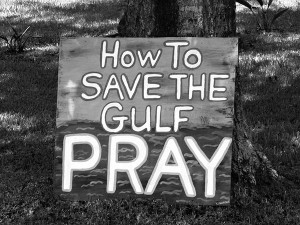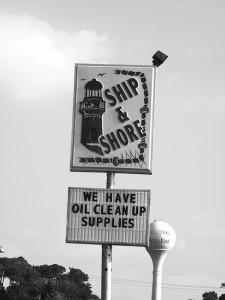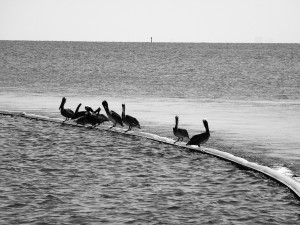The BP Disaster as an Exxon Valdez Rerun
On April 20, 2010, eleven people were killed when the Deepwater Horizon drilling rig exploded.
Owned by Transocean Ltd. and contracted to BP, the rig burned in the Northern Gulf of Mexico until it eventually collapsed, leaving a breached wellhead gushing an estimated 55,000 barrels of oil per day. Some 185 to 205 million gallons of crude oil were released before the wellhead could be capped in July and permanently sealed in September, nearly five months after the initial explosion.
As this environmental disaster unfolded, the nation witnessed riveting reporting. Oil penetrated crucial coastal marshes and washed up on white sandy beaches. The individuals and communities who depend on the Gulf of Mexico for their livelihoods watched, too, worried about the economic and socio-cultural effects, as well as how to get compensated for damages.
Over a year later, there’s no more 24-hour CNN coverage. If one were to rely solely on media accounts, it might seem that the Deepwater Horizon disaster is over. One New York Times headline from February 1, 2011 read: “Report Foresees Quick Gulf of Mexico Recovery”—yet the article goes on to say, “The 39-page report acknowledges that any definitive assessment at this point is impossible, and that fully understanding the spill’s ecological effects will take years.” Not surprisingly, more pressing national and international events have caught the media’s attention. Most Gulf waters have been reopened for fishing, seafood is being tested and deemed safe for human consumption, and beaches have long since been declared clean and, in fact, inviting. Still, economic and social upheaval will likely leave the communities along the Northern Gulf of Mexico (the Gulf) in disarray for the foreseeable future.

It’s difficult for those who haven’t experienced an environmental or “technological” disaster to fully understand what people and communities along the Gulf are going through. Among researchers and in the general public, there’s a broad tendency to distinguish between “natural” disasters and technological or environmental disasters. It is perhaps most useful to think about disasters as existing on a continuum, with “natural” disasters at one end and human-caused disasters at the other. While these events’ qualities and characteristics overlap in terms of their social impacts, what we typically refer to as natural disasters (such as tornadoes, earthquakes, and hurricanes) are considered “Acts of God.” There is no one to blame, and, in most cases, communities are able to come together to rebuild and move on. At the other end of the continuum, technological disasters such as Chernobyl, Bhopal, and the BP oil spill are triggered by human error. These tend to result in long-term community disruption and chronic psychological stress.
As psychologist Michael Edelstein has noted, “outsiders” often don’t understand why environmental disaster survivors can’t just move on. And if outsiders can’t understand, they are less likely to offer support, and that further impedes community recovery. It is our hope that the past can offer some lessons in how best to approach long-term recovery in the Gulf.
Community Ties to the Environment
Sociologists Steve Kroll-Smith and Steve Couch’s ecological-symbolic approach to disasters asserts that community recovery and interpretive processes are influenced by the type of environment damaged and the community’s relationship to that environment. Renewable resource communities (RRCs) like those affected by the EVOS in Alaska are particularly vulnerable to the effects of an environmental disaster. They depend on renewable natural resources for their social, cultural, and economic existence. As noted by Steve Picou and Duane Gill, sociologists who have studied the EVOS for more than 20 years, understanding environment-social relationships between these aspects of life in RRCs is essential to understanding the often ignored human side of environmental disasters.

Particularly for commercial fishermen and Alaska Natives in Cordova and other oiled communities, the consequences of EVOS-related environmental degradation have been enormous. These include empirically-documented elevated levels of collective trauma, social disruption, economic uncertainty, community strain, and psychological stress. Notably, the chronic community impacts of the EVOS are directly tied not only to the actual loss of various types of resources, but also to the threat of the future loss of resources.
It is in this context that we consider the situation for communities along the Gulf in the aftermath of the Deepwater Horizon blowout. This disaster damaged marine ecosystems and resources to an extent that has yet to be fully realized. Additionally, the dispersants used to mitigate the impacts of the spill threaten several “at-risk” industries along the northern Gulf. Commercial and recreational fishing, tourism, and other enterprises tied to natural resources have already suffered severe economic losses and the threat of loss continues. In particular, there remains uncertainty regarding the recovery of shrimp, oysters, crab, and other fish. As in Alaska, there are also Native American groups such as the Houma in Louisiana that have strong cultural ties to the natural environment that were threatened or damaged by the oil and dispersants.
Data collected in communities along the Gulf of Mexico in the months since the BP spill reveal high levels of psychological stress among groups that rely on renewable natural resources for their livelihoods, as well as concerns related to health as a result of exposure to the oil and dispersants. In Alabama, for example, we found that the strongest predictors of stress were family health concerns, commercial ties to renewable resources, and concern about economic future, economic loss, and exposure to the oil. Unfortunately, the experiences of Gulf communities resonate with the ongoing narratives of Alaskans over the two decades following the EVOS.
Invisible Trauma

In a milieu of general uncertainty regarding the range and scope of environmental contamination, there is also confusion about the nature and extent of health-related impacts, economic impacts, and social impacts. Social impacts are particularly detrimental when they are the result of the kind of long-term social disruption often associated with technological disasters.
The Money Spill
The complexity of the coastal economy along the Northern Gulf of Mexico far exceeds that of the region affected by the EVOS in Alaska. To date, the diverse yet intertwined oil and gas extraction economies, tourism or “beach” economies, and commercial fishing economies have all experienced direct and indirect impacts of the BP oil spill. The temporary Federal moratorium on deepwater drilling hurt Louisiana communities dependent on the oil and gas industry for their livelihoods. Many areas in Alabama and Florida were hit by declines in tourism because potential visitors were concerned about oiled beaches and toxic waters unsuitable for swimming, as well as restrictions on recreational marine boating and sport fishing. And similar concerns related to the safety of seafood from the Gulf have been far-reaching, shaking consumer confidence and causing disruptions to the commercial fishing industry, including seafood harvesting, processing, and distributing. This hurt markets that were already mired in the process of rebounding from the effects of Hurricanes Katrina and Rita in 2005. From this perspective, the economic recovery of coastal communities is strongly related to perceptions of seafood consumers and tourists around the country—which further confounds community recovery.
Conversely, in the weeks and months after the Deepwater Horizon blowout there was considerable social and economic disruption associated with the “money spill”—the large amounts of money being spent on oil spill mitigation and clean-up efforts. As was the case in the Exxon Valdez disaster, in which those who made money on clean-up efforts were referred to as “spillionaires” and “Exxon whores,” the money spill and ensuing economic disruption along the Gulf fostered problems in many communities. In media accounts and in our own interviews, some residents expressed frustration with perceived inequalities in chances to work on the Vessels of Opportunity program. For example, some locals felt shut out by the contracting process, growing particularly agitated in cases where they saw people from outside the area having their boats hired. Unequal access to resources associated with the money spill pitted family, friends, and neighbors against each other.
As in the wake of the EVOS, this money spill contributed to social upheaval and the emergence of a “corrosive community.” This term, coined by environmental sociologists Bill Freudenburg and Timothy Jones in the 1990s, refers to post-disaster social environments in which social relationships are altered, social support breaks down, and civil order is disrupted. Notably, corrosive communities typically emerge following human-caused disasters, rather than in the context of natural disasters. If the community experience with the EVOS is any indication, this damage to social networks and the long-term potential for diminished social capital—trust and social ties—is very real. Loss of social capital may further increase stress levels, affecting overall community well-being. In addition, there is a strong possibility for outmigration from coastal communities as a result of declining economic conditions related, at least in part, to the BP spill. In Alabama, one-third of our survey sample indicated a desire to move from their community. Should this occur, Gulf communities will lose not only social capital, but also human capital.
Impersonality and Collective Stress
Although separated by more than 20 years, both the EVOS and the BP disasters highlight critical issues of recreancy (blame), responsibility, and loss of trust in corporations and government. These are all characteristic of human-caused disasters. In the months following the Deepwater Horizon blowout, frustration and anger over accountability, lack of transparency, and finger-pointing escalated in coastal states and the halls of Washington. For its part, as if following the Exxon playbook, BP continues to downplay the amount of oil that was released into the Gulf and tries to spread the blame to Halliburton for a faulty cement job and Transocean for operating an unsafe rig. This corporate posturing sets the stage for BP to minimize financial responsibility for resulting environmental, economic, and social damages.
Relative to the grounding of the Exxon Valdez, public responses to the rig explosion suggest higher levels of perceived complicity and corruption between BP and the former federal Minerals Management Service (now the Bureau of Ocean Energy Management, Regulation, and Enforcement). More than two decades of data regarding attitudes toward government, big business, and the U.S. legal system in the context of the EVOS show that beliefs about trust and blame are related to frustration, anger, alienation, and stress. Given this empirical evidence, we can expect these or similar outcomes to escalate over time among Gulf Coast residents.
Corporations like Exxon and BP aren’t designed to react to the demands of those seeking compensation from a responsible party after a disaster. When it comes to dealing with claimants and the public, their corporate cultures and bureaucratic structures seem impersonal and insensitive. Government bureaucracies and our justice system aren’t much better at responding to survivors of environmental disasters. Interacting with the impersonality of corporate and government bureaucracies and engaging with the legal system not only exacerbates existing stress, it creates new stress for victims.
In the months since the BP disaster, the financial claims process has, indeed, become a bureaucratic and legal obstacle, as well as a source of contention and stress. Despite the unprecedented establishment of a $20 billion escrow fund to compensate those affected by the spill, the Governor of Alabama has characterized the process as “extortion.” In March 2011, eleven months into the cleanup, the Gulf Coast Claims Facility reported that of 155,000 claims applications submitted for full or interim payments, just 25 percent had been processed. Many people filing claims have expressed frustration, anger, and a sense of futility around the process. With its pronouncements to pay “legitimate” claims and to make survivors “whole,” BP’s public relations campaign has mirrored that of Exxon’s in 1989. Similarly, President Obama’s remark that the compensation funds represent “an important step towards making the people of the Gulf Coast whole again” hasn’t instilled confidence among those who lived through the EVOS. As one Alaskan put it: “That’s lawyer speak for ‘we’re going to pay out as little as possible.’”
litigation as “secondary trauma”
Minimal financial support from the BP claims process has caused many who believe they’ve incurred unpaid losses to resort to litigation. This, too, is reminiscent of the predicament in which many commercial fishermen in Alaska found themselves after the EVOS. Following the EVOS, and now in the wake of the BP disaster, it is apparent that there are some things that aren’t valued or even considered in the calculation of damages. How does one calculate the value of the base of a food chain—plankton, larval fish, and many bottom dwelling organisms—species that are difficult to see with the naked eye? How do we assign value to a way of life that is lost to human-caused environmental contamination? In the case of the EVOS, Alaska Native claims of damage to their cultural heritage and subsistence practices were dismissed in Federal Court. Moreover, actual damage claims didn’t include losses incurred after the case went to trial in 1994. Shortly after going to trial, the multi-million dollar herring fishery collapsed and, to this date, has not recovered.
BP spill-related litigation will be delayed until 2013 and is likely to result in protracted legal processes for literally thousands of Gulf Coast residents. Research tells us that this will prolong the social impacts of the disaster, leaving most plaintiffs with a lack of closure. With the precedent set by Exxon v. Baker, which took almost two decades to wind through the U.S. judicial system, we can anticipate prolonged litigation-related stress for those involved. If it follows the pattern documented in Alaska, this “secondary trauma” could prove as stressful as the initial disaster itself. Coupled with other chronic social impacts previously discussed we must expect high levels of stress among individuals, groups, and communities to continue. If damage awards through the BP claims process remain contentious and redress through the courts is delayed, mental health problems and community disruption will persist for decades along the Gulf Coast.
Disasters like the BP oil spill are what Kai Erikson, a sociologist who studies social consequences of catastrophic events, describes as a “new species of trouble” that “scare human beings in new and special ways… elicit[ing] an uncanny fear.” And as German sociologist Ulrich Beck suggests, these events also represent risks that are a major feature of contemporary society. The cumulative impacts of hurricanes Katrina, Rita, and Wilma in 2005, Ivan in 2004, and now the BP oil spill disaster are intensified by the global economic crisis and our continued reliance on fossil fuels. Together, these stressors take a toll on various forms of community capital, including financial, human, social, built, political, natural, and cultural capital.
Recommended Resources
Edelstein, Michael. Contaminated Communities: The Social and Psychological Impacts of Residential Toxic Exposure (Westview Press, 1988, 2004). Presents social and psychological impacts arising from residential toxic exposure.
Erikson, Kai T. Everything in its Path: Destruction of Community in the Buffalo Creek Flood (Simon and Schuster, 1976). The seminal qualitative study of the 1972 Buffalo Creek, West Virginia disaster.
Freudenburg, William R. and Robert Gramling. Blowout in the Gulf: The BP Oil Spill Disaster and the Future of Energy in America (MIT Press, 2011). An analysis of the origins of the Deepwater Horizon explosion and its aftermath.
Kroll-Smith, J. Stephen and Stephen R. Couch. The Real Disaster is Above Ground: A Mine Fire and Social Conflict (The University Press of Kentucky, 1990). Examines the effects of an environmental disaster on the community of Centralia, Pennsylvania.
Picou, J. Steven, Duane A. Gill, and Maurie J. Cohen (eds.). The Exxon Valdez Disaster: Readings on a Modern Social Problem (Kendall-Hunt, 1999). Provides a general introduction to technological disasters as a social problem.
